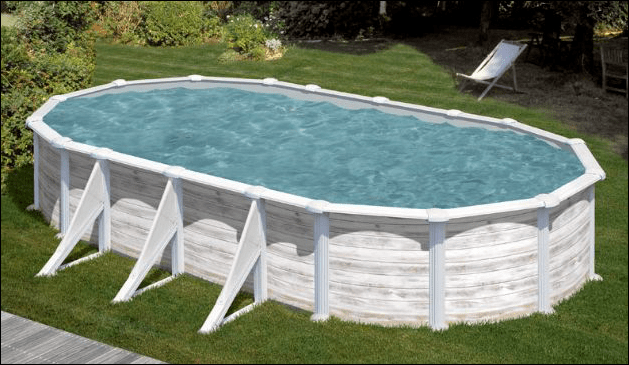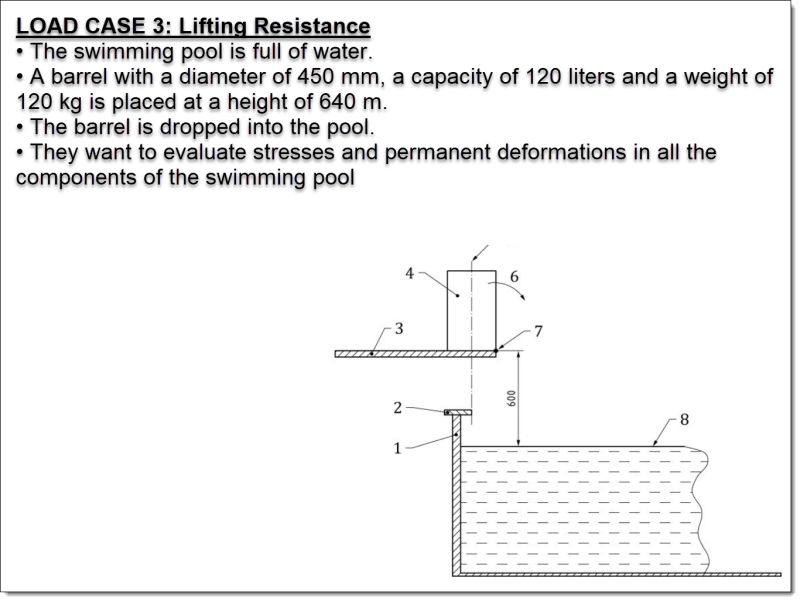BlasMolero
Mechanical
Hello Experts!,
For the study of the structural behavior of the walls of a typical swimming pool meshed with 2-D Shell CQUAD4 elements I need to simulate in Simcenter FEMAP with NASTRAN the loading effect of a barrel of 120 kg dropping over the free surface of the water:
[ul]
[li]The pool is full of water.[/li]
[li]A barrel with a diameter of 450 mm and a capacity of 120 liters and weight of 120 kg is placed at 640 mm over the surface of the water.[/li]
[li]The barrel is dropped over the pool.[/li]
[li]We need to calculate the pressure distribution in the walls of the pool to perform structural analysis to obtain stresses & displacements results.[/li]
[/ul]


The key here is to know how to estimate in a reasonable way in FEMAP (not very conservative neither under-estimate or incorrect) the peak pressure load distribution that receive the walls of the pool due to the impact of the barrel using an equivalent static loading, the real situation is obviously very complex.
It is not immediately clear to me how it could be simplified to a loading scenario which would make for a meaningful analysis.
If anybody have some ideas as to how to proceed is welcome, please inform, thanks!.
Best regards,
Blas.
~~~~~~~~~~~~~~~~~~~~~~
Blas Molero Hidalgo
Ingeniero Industrial
Director
IBERISA
48004 BILBAO (SPAIN)
WEB: Blog de FEMAP & NX Nastran:
For the study of the structural behavior of the walls of a typical swimming pool meshed with 2-D Shell CQUAD4 elements I need to simulate in Simcenter FEMAP with NASTRAN the loading effect of a barrel of 120 kg dropping over the free surface of the water:
[ul]
[li]The pool is full of water.[/li]
[li]A barrel with a diameter of 450 mm and a capacity of 120 liters and weight of 120 kg is placed at 640 mm over the surface of the water.[/li]
[li]The barrel is dropped over the pool.[/li]
[li]We need to calculate the pressure distribution in the walls of the pool to perform structural analysis to obtain stresses & displacements results.[/li]
[/ul]


The key here is to know how to estimate in a reasonable way in FEMAP (not very conservative neither under-estimate or incorrect) the peak pressure load distribution that receive the walls of the pool due to the impact of the barrel using an equivalent static loading, the real situation is obviously very complex.
It is not immediately clear to me how it could be simplified to a loading scenario which would make for a meaningful analysis.
If anybody have some ideas as to how to proceed is welcome, please inform, thanks!.
Best regards,
Blas.
~~~~~~~~~~~~~~~~~~~~~~
Blas Molero Hidalgo
Ingeniero Industrial
Director
IBERISA
48004 BILBAO (SPAIN)
WEB: Blog de FEMAP & NX Nastran:

![[smile] [smile] [smile]](/data/assets/smilies/smile.gif) . And that may be entirely irrelevant
. And that may be entirely irrelevant